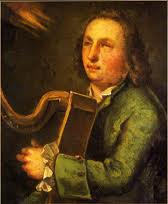Annotation:Carolan's Concerto: Difference between revisions
No edit summary |
No edit summary |
||
| Line 13: | Line 13: | ||
<br> | <br> | ||
<br> | <br> | ||
[[File:carolan.jpg|260px|thumb|left|Turlough O'Carolan]] | [[File:carolan.jpg|260px|thumb|left|Turlough O'Carolan]] | ||
The tune was printed in John Lee's '''A Favourite Collecgtion of the so much admired old Irish Tunes, the original and genuine compostions of Carolan, the celebrated Irish Bard. etc.''' (Dublin, 1780), where it appears as "[[Mrs. Poer]]." | The tune was printed in John Lee's '''A Favourite Collecgtion of the so much admired old Irish Tunes, the original and genuine compostions of Carolan, the celebrated Irish Bard. etc.''' (Dublin, 1780), where it appears as "[[Mrs. Poer]]." | ||
Revision as of 05:20, 31 January 2019
X:1 T:Carolan's Concerto M:C L:1/8 Q:"Allegro" B:Bunting - General Collection of the Ancient Music of Ireland (1796, No. 42) Z:AK/Fiddler's Companion R:Air K:Eb e2e2e2 dc|BcBA .G2.B2|.F2.B2.E2.B2|(cd)(ef) .d2.B2|e2b2 (ga)(bg)| (fg)(af) (ga)b2|(a2c'2) (ga).b2|(agfe d2).B2|.c2 z2 (ca)(ca)|B2 z2(Bg)(Bg)| A2z2 AfAf|{f}(edc>d B2) BA|(GABG) (FGAF)|(GABG) (ABcA)|B2e2 {g}f2 ed| e2E2E2 z2::(BAGF) E2.B2|D2B2C2c2|(d2f2) (ed)(cB)|(c2g2) (fe)(dc)| (Bb)(Bb) (Aa)(Aa)|GgGg FfFf|EeEe defd|BbBb AaAa|GgGg FfFf| e e2d2c2B-|BA2G2F2E|(BEGE) (BEGE)|(cFAF) (cFAF)|(BEGB) (AGFE)| (BEGB) (AGFE)|(FGAB cdef)|(edcB e2)[G2e2]|[G4e4]z4:|]
CAROLAN'S CONCERTO (Ceolcuirm Uí Cearballain). AKA – "O'Carolan's Concerto." AKA and see "Mrs. Power," "Mrs. Power of Coorheen," "Mrs. Poer." Irish, Air or Planxty (4/4 time). E Flat Major (Bunting, Haverty): D Major (most versions): G Major (Complete Collection...). Standard tuning (fiddle). AABB (most versions): AB (Bunting, Haverty, Mallinson, O'Sullivan): One part (Williamson). The air is considered to be the most famous composition of blind Irish harper Turlough O'Carolan (1670–1738) who fashioned it in honour of Elizabeth Keating, who became Mrs. Power of Coorheen (County Galway) when she married David Power (the subject of another of Carolan's compostions). The tune is sometimes known by the name "Mrs. Power" (she was also the mother of Fanny Power, the title of another of O'Carolan's famous compositions). It was also Carolan's own favorite among his compositions, according to Grattan Flood. Irish Collector Edward Bunting (1773–1843), in the preface to his General Collection of the Ancient Irish Music (London, 1796), says that in this piece and "Madam Cole" "the practitioner will perceive evident imitations of Corelli, in which the exuberant fancy of that admired composer is happily copied." The name 'concerto' perhaps became attached to the tune because of a famous, colorful story of dubious veracity (but nevertheless persistent), retold by Grattan Flood (1906) and Williamson (1976) among others (and critically examined by Donal O'Sullivan), of an incident between O'Carolan and the famous Italian violinist and composer Gemeniani, who was then resident in Dublin. Hearing of O'Carolan's musical skill and wishing to test him, Geminiani sent him a piece of Italian music which he had altered to include very subtle and changes and flaws. Upon being presented with the music through an intermediary O'Carolan listened to the piece and praised it but said, in Irish, "Here and there it limps and stumbles." He instructed the correction of the piece and had it sent back to Geminiani who is then said to have declared him il genio vero della musica. It has been remarked upon that the piece seems to contain influences of various Italian masters, especially Corelli, whose music Carolan was said to have admired. The air was played by one of ten Irish harp masters in competition, recorded the Belfast Northern Star of July 15th, 1792, at the last great convocation of ancient Irish harpers, the Belfast Harp Festival, held that week. See also note for "Annotation:Mrs. Power/Poer" for more on this tune.

The tune was printed in John Lee's A Favourite Collecgtion of the so much admired old Irish Tunes, the original and genuine compostions of Carolan, the celebrated Irish Bard. etc. (Dublin, 1780), where it appears as "Mrs. Poer."
